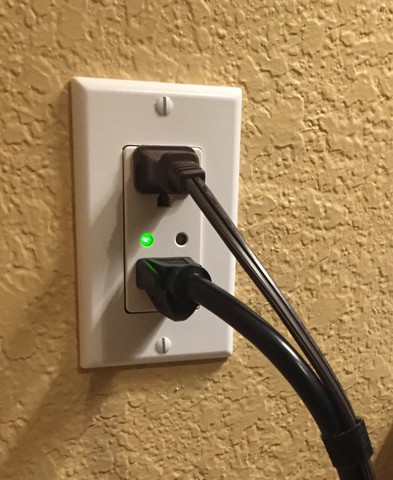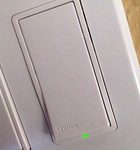
The Leviton DZR15 outlet provides a convenient method of controlling loads without having a separate module cluttering things up. This unit installs in place of a standard wall outlet and provides two sockets: one switched, and one unswitched.
The unit is very easy to pair with most home automation hubs.
Notes
NOTE: There is some indication that Leviton may have updated this outlet without changing the model number. Online documentation states that Local Sensing and Network Wide Inclusion are supported. Local Sensing does not work on mine, and I don’t believe NWI does either, so they may be (at the very least) an older firmware revision, and possibly an older hardware revision.
Two of these outlets are currently controlling a pair of table lamps on opposite sides of my living room. Like the DZS151 switches, a mechanical relay is used to switch the load. They work about as you would expect.
Installation was relatively simple, but minor rewiring was required. The existing outlets in my house have two pairs of connected terminals; power comes in on the top pair, and wires from the bottom pair provide power to another outlet (or other load) somewhere else in a parallel daisy chain. To use these outlets, I had to bundle those wires and add a pigtail to provide power to the outlet.
Annoying, but not a showstopper.
Pairing was easy, and they work fairly well. My only complaint so far is that one of them failed within two weeks of installation. The Wink still saw it and could turn it on and off; the indicator on the outlet would turn on and off, and you could hear the relay clicking inside, but the load remained on no matter what. I have since replaced that outlet with another identical unit; I hope that will be the end of it.
The failure does not inspire confidence. I’ll be trying another manufacturer next time (probably GE).
Pros
- Easy to install.
- Reliable when they work.
- Helps extend your Z-Wave mesh.
- Eliminates external modules for controlling lamps.
Cons
- Does not have daisy-chain terminals; requires a pigtail in some use cases.
- Supports 12AWG wire, but it is more difficult than it should be to work with. A little more travel on the screws would have solved that.
- Only one outlet is switched; it would be nice if both were separately switched.
- Uses a mechanical relay, producing an audible click when actuated.
- Does not support Instant Status. This is a minor issue, however, as manually switching the outlet is a fairly rare event.
- 50% failure rate in two weeks (so far).
Updated for standard feature table, to fix a broken link, and to point out a possible issue with hardware/firmware revisions. ↩︎

